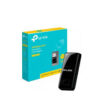TP-Link TL-WN823N 300Mbps Mini Wireless N USB Adapter Proftech
TP-Link TL-WN823N 300Mbps Mini Wireless N USB Adapter transforms any USB-enabled device into a wireless-capable system, providing 802.11n connectivity for computers, laptops, and compatible devices lacking built-in Wi-Fi functionality. This compact adapter delivers wireless speeds up to 300 Mbps while maintaining a low-profile design that won’t obstruct adjacent USB ports or create unsightly protrusions.
Unlike larger USB Wi-Fi adapters that block neighboring ports or require extension cables, this mini adapter’s streamlined form factor allows multiple USB devices to coexist comfortably. The device supports modern wireless security protocols and offers plug-and-play installation on most operating systems, making wireless connectivity accessible for older computers, desktop workstations, and specialized equipment originally designed for wired-only operation.
Wireless Performance and Technical Capabilities
802.11n Standard and Speed Specifications
The TP-Link TL-WN823N 300Mbps Mini Wireless N USB Adapter operates on proven wireless technology:
- Maximum throughput: Up to 300 Mbps theoretical speed on 2.4GHz frequency band
- MIMO technology: Multiple antenna design improves signal quality and reliability
- Backward compatibility: Supports 802.11g and 802.11b devices and networks
- Channel bandwidth: 20/40 MHz channel width support for enhanced performance
Real-World Performance Expectations
Practical speed testing reveals typical performance in various usage scenarios:
- Close-range performance: 80-150 Mbps within 30 feet of wireless router
- Medium-distance connectivity: 40-80 Mbps at 50-75 feet with minimal obstacles
- Extended range operation: 15-40 Mbps near wireless coverage boundaries
- Interference considerations: Performance varies with neighboring network density and electronic interference
Compact Design and Physical Specifications
Mini Form Factor Advantages
The ultra-compact design provides several practical benefits:
- Minimal port obstruction: Small profile leaves adjacent USB ports accessible
- Portable operation: Easily transported between different computers or locations
- Discrete appearance: Low-profile design doesn’t draw attention or create visual clutter
- Reduced damage risk: Compact size less likely to be accidentally bumped or broken
Physical Construction and Durability
- Dimensions: Approximately 18.9 × 15.5 × 7.5 mm (0.74 × 0.61 × 0.30 inches)
- Weight: Under 5 grams for negligible impact on laptop portability
- USB 2.0 interface: Standard USB-A connector ensures universal compatibility
- LED indicator: Status light confirms power and wireless connection activity
Operating System Compatibility and Driver Support
Comprehensive OS Support
The TP-Link TL-WN823N 300Mbps Mini Wireless N USB Adapter works across multiple platforms:
- Windows compatibility: Windows 11, 10, 8.1, 8, 7, XP, and Vista support
- macOS integration: Compatible with recent macOS versions through built-in drivers
- Linux support: Most distributions recognize the device without additional configuration
- Driver availability: Downloadable drivers for specialized or older operating systems
Installation Process and Setup
Getting connected requires minimal technical knowledge:
- Plug-and-play operation: Most modern systems automatically install necessary drivers
- Manual driver installation: Available for systems requiring specific driver versions
- Wireless network detection: Automatic scanning for available networks
- Security configuration: Support for WEP, WPA, and WPA2 encryption protocols
Practical Applications and Use Cases
Desktop Computer Wireless Enablement
Many desktop computers lack built-in wireless capabilities, making this adapter essential:
- Older desktop systems: Retrofit wireless connectivity without internal card installation
- Custom-built computers: Add Wi-Fi to systems where wireless wasn’t initially planned
- Office workstations: Enable wireless connectivity without modifying corporate hardware
- Gaming PCs: Provide wireless backup when ethernet connections become unavailable
Laptop Wi-Fi Repair and Upgrade Scenarios
Existing laptops may benefit from external wireless adapters:
- Failed internal Wi-Fi cards: Temporary or permanent replacement for broken wireless modules
- Driver conflicts: Bypass problematic internal wireless hardware
- Performance upgrades: Enhanced wireless capability for older laptops with slower built-in adapters
- Dual-network scenarios: Simultaneous connection to different wireless networks
Network Security and Connection Management
Wireless Security Protocol Support
Modern encryption standards protect network communications:
- WPA3 compatibility: Latest security standard for enhanced protection
- WPA2 support: Widespread compatibility with existing secured networks
- WEP backward compatibility: Connection to older networks requiring legacy security
- Enterprise authentication: 802.1X support for business network environments
Connection Management Features
Software utilities provide comprehensive wireless network control:
- Network profile storage: Automatic connection to frequently used networks
- Signal strength monitoring: Real-time assessment of connection quality
- Advanced settings: Manual channel selection and power management options
- Roaming capabilities: Seamless transition between access points in extended networks
Performance Optimization and Troubleshooting
Maximizing Wireless Performance
Several factors influence the adapter’s effectiveness:
- USB port selection: USB 3.0 ports may provide better power delivery and stability
- Antenna positioning: Optimal orientation toward wireless router or access point
- Interference avoidance: Distance from other electronic devices and metal obstacles
- Network congestion: Performance varies with number of simultaneous users
Common Issues and Solutions
Typical problems and their resolutions help maintain reliable connectivity:
- Intermittent connections: Driver updates and USB port changes often resolve issues
- Slow speeds: Network congestion and router distance significantly impact performance
- Recognition problems: Manual driver installation required for some systems
- Range limitations: Physical obstacles and interference sources affect coverage
Limitations and Alternative Considerations
Technology Constraints
The TP-Link TL-WN823N 300Mbps Mini Wireless N USB Adapter operates within specific boundaries:
- Single-band operation: 2.4GHz only, lacking 5GHz band for interference avoidance
- Wireless N limitations: Slower than AC or newer standards available in modern equipment
- USB 2.0 interface: May bottleneck very high-speed wireless connections
- Antenna design: Internal antenna less effective than external antenna solutions
When to Consider Alternatives
Different solutions may provide superior performance for specific requirements:
- High-speed internet: Homes with gigabit internet may require AC or AX adapters
- Gaming applications: Low-latency requirements might benefit from wired connections
- Professional environments: Enterprise features may require more advanced adapters
- Extended range: Larger adapters with external antennas provide better coverage
Value Proposition and Cost Effectiveness
Budget-Friendly Connectivity Solution
This adapter provides affordable wireless access for various scenarios:
- Economic desktop upgrades: Less expensive than internal wireless card installation
- Temporary solutions: Cost-effective backup connectivity during equipment repairs
- Multiple device support: Single adapter can be shared between different computers
- Travel convenience: Portable wireless capability for business or leisure trips
Long-Term Utility Assessment
Understanding the device’s role in evolving technology landscapes:
- Compatibility longevity: Wireless N support will continue for years despite newer standards
- Replacement timing: Eventual upgrade to AC or AX standards as internet speeds increase
- Backup utility: Permanent value as emergency wireless connectivity option
- Legacy system support: Ongoing relevance for older computers requiring wireless access
Installation Environment and Compatibility Factors
Optimal Usage Scenarios
The adapter performs reliably under specific conditions:
- Modern routers: AC or newer routers provide backward compatibility with enhanced performance
- Clean RF environment: Areas with minimal wireless interference yield higher speeds
- Reasonable distances: Performance degrades significantly beyond 100 feet from access points
- Standard applications: Web browsing, email, and streaming work well within adapter capabilities
System Requirements and Prerequisites
- Available USB port: USB 2.0 or higher required for proper operation
- Adequate power supply: Some laptops may require powered USB hubs for stable operation
- Driver compatibility: Operating system must support device drivers
- Network access: Existing wireless network with compatible security settings


 No products in the cart.
No products in the cart. 
Reviews
There are no reviews yet.